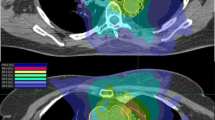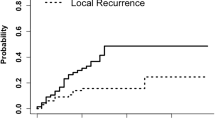Purpose:
To analyze the outcome of reirradiation of recurrent/metastatic or new primary tumors with three-dimensional conformal (3D-CRT) or stereotactic (SRT) techniques.
Patients and Methods:
108 patients reirradiated between 01/2002 and 01/2005 at the European Institute of Oncology, Milan, Italy, were analyzed. Primary diagnosis included breast, lung, head/neck, urologic tumors, and other primaries. Curative and palliative intent were applied to 27 (25%) and 81 patients (75%), respectively. 3D-CRT and SRT were employed in 57 (53%) and 48 patients (44%), respectively, up to a mean dose of 23 Gy.
Results:
Median follow-up was 7 months (range, 1–50 months). Response, stabilization, and progression were observed in 33%, 36%, and 17% of patients, respectively (15 patients were not evaluable). No severe toxicity was reported. Median overall survival amounted to 32.6 months and was longer in patients treated with curative intent.
Conclusion:
A small portion of patients can be cured with a second course of radiotherapy, and in many cases, palliation can be obtained. Low toxicity of reirradiation with use of modern techniques should allow for the delivery of higher doses and, in consequence, lead to an improvement in reirradiation outcome.
Ziel:
Analyse der Therapieergebnisse nach Rebestrahlung von Rezidivtumoren, Metastasen oder Zweittumoren mit dreidimensionaler Konformationsstrahlentherapie (3D-CRT) oder stereotaktischer Radiotherapie (SRT).
Patienten und Methodik:
108 zwischen 01/2002 und 01/2005 am European Institute of Oncology, Mailand, Italien, rebestrahlte Patienten wurden analysiert. Bei Erstdiagnose lagen Tumoren der Mamma, der Lunge, des HNO-Bereichs sowie urologische und andere Tumoren vor. 27 Patienten (25%) wurden mit kurativer Zielsetzung und 81 (75%) in palliativer Absicht mit einer mittleren Gesamtdosis von 23 Gy bestrahlt.
Ergebnisse:
Die mediane Nachbeobachtungszeit betrug 7 Monate (1–50 Monate). Ansprechen, Stabilisierung und Progression wurden bei 33%, 36% und 17% der Patienten beobachtet. 15 Patienten konnten nicht ausgewertet werden. Schwerwiegende Toxizität wurde nicht beobachtet. Das mediane Gesamtüberleben lag bei 32,6 Monaten und war bei Patienten, die in kurativer Absicht behandelt wurden, länger.
Schlussfolgerung:
Ein kleiner Teil der Patienten kann durch eine Rebestrahlung in Remission gebracht werden, in vielen Fällen lässt sich eine Palliation erreichen. Die gute Verträglichkeit der Rebestrahlung bei Verwendung moderner Techniken ermöglicht zukünftig die Applikation einer höheren Dosis und damit evtl. auch eine weitere Verbesserung der Ergebnisse.
Similar content being viewed by others
Author information
Authors and Affiliations
Corresponding author
Rights and permissions
About this article
Cite this article
Jereczek-Fossa, B.A., Kowalczyk, A., D'Onofrio, A. et al. Three-Dimensional Conformal or Stereotactic Reirradiation of Recurrent, Metastatic or New Primary Tumors. Strahlenther Onkol 184, 36–40 (2008). https://doi.org/10.1007/s00066-008-1783-9
Received:
Accepted:
Issue Date:
DOI: https://doi.org/10.1007/s00066-008-1783-9




